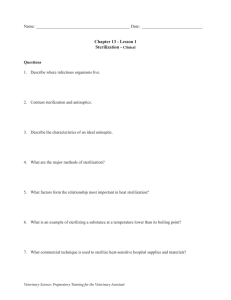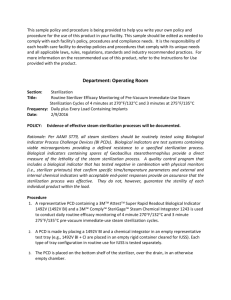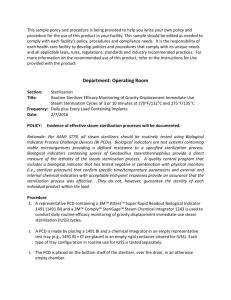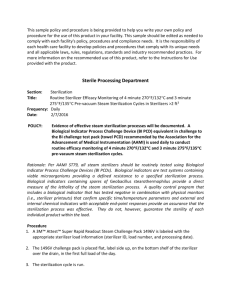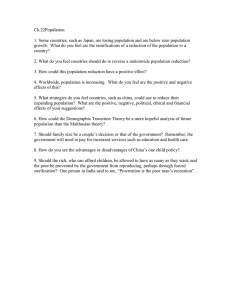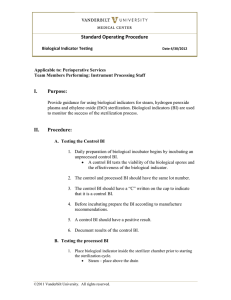Proper Decontamination and Immediate-use Steam
advertisement
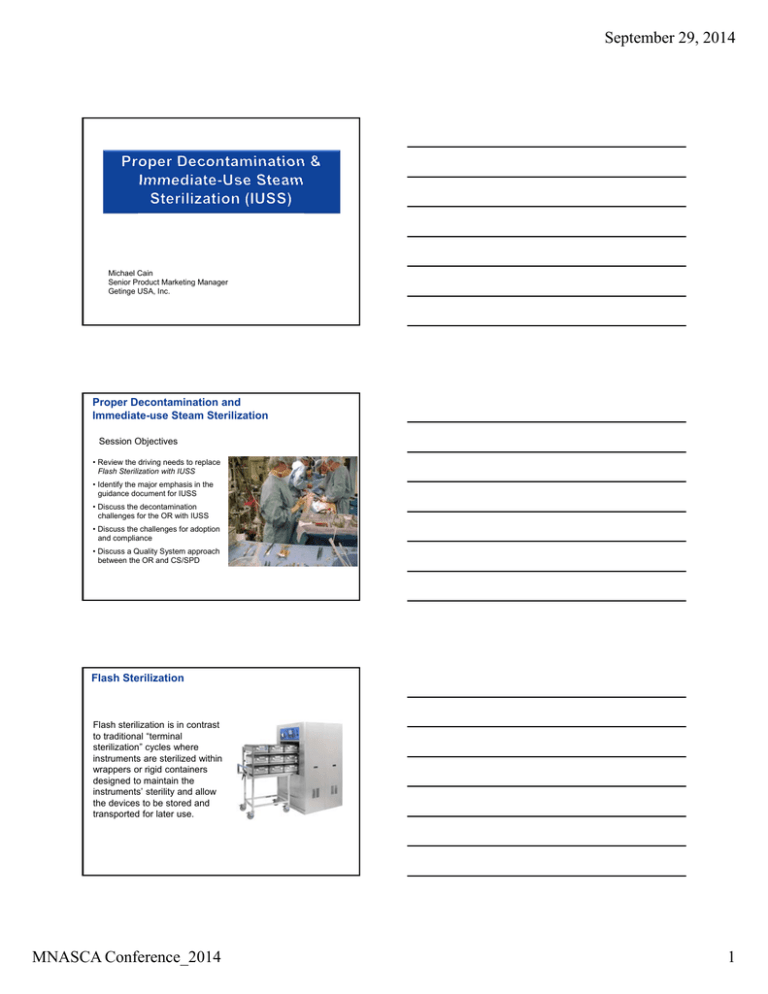
September 29, 2014 Michael Cain Senior Product Marketing Manager Getinge USA, Inc. Proper Decontamination and Immediate-use Steam Sterilization Session Objectives • Review the driving needs to replace Flash Sterilization with IUSS • Identify the major emphasis in the guidance document for IUSS • Discuss the decontamination challenges for the OR with IUSS • Discuss the challenges for adoption and compliance • Discuss a Quality System approach between the OR and CS/SPD Flash Sterilization Flash sterilization is in contrast to traditional “terminal sterilization” cycles where instruments are sterilized within wrappers or rigid containers designed to maintain the instruments’ sterility and allow the devices to be stored and transported for later use. MNASCA Conference_2014 1 September 29, 2014 Flash Sterilization “Flash sterilize” describes steam sterilization cycles where unwrapped medical devices (instruments) are subjected to an abbreviated (short) steam exposure time @ sterilization temperature, with little or no drying time. . . . . . and then used promptly after the cycle completion, without being stored for future use. Reasons for FLASH Sterilization • Contaminated dropped instrument • Inadequate instrument inventories • Booking cases back-to-back • Items not available from SPD when needed oNot aware of the turn-around time required for wrapped sterilization from SPD • Instrument(s) needed for an emergency procedure • Specialized instruments sterilized only by the “unwrapped” method prior to use Unacceptable Reasons for FLASH Sterilization • Insufficient instrumentation for scheduled cases • Items not available from SPD as requested • Putting surgeons’ schedules ahead of patient safety MNASCA Conference_2014 2 September 29, 2014 Flash Sterilization is No Longer Appropriate Convenience and poor oversight compromise the effectiveness of “emergency flash sterilization”. Improper processes can lead to the use of contaminated instruments in surgery resulting in serious consequences, including surgical site infections (SSI). Flash Sterilization is No Longer Appropriate • SSI or healthcare associated infection (HAI) is the No. 1 concern of improper “flash” sterilization • According to the CDC, SSI’s affect 2 to 5 percent of all patients undergoing surgery • This equals about 300,000 patients each year Flash Sterilization Is No Longer Appropriate • Patients with SSI have a 3% mortality rate • SSI’s increase hospital stays by 7 to 10 days • The increased hospital stays equates to increased cost of $3,000 to $29,000 per SSI with upward of $10 billion in extra cost annually (CDC 2011). MNASCA Conference_2014 3 September 29, 2014 Flash Sterilization is No Longer Appropriate • There are many causes of SSI’s and improper sterilization is just one factor. • Nonetheless, reducing reliance on “flash” sterilization improves quality and safety, and reduces risk to the patient. • And we are here for the patients! “Flash” Sterilization is now “Immediate-Use Steam Sterilization” AAMI, AORN, APIC and other health and safety organizations have agreed that “flash sterilization” is an antiquated term that does not fully describe the various steam sterilization cycles now in use to process items NOT intended to be stored for later use. Current IFU requirements may require longer exposure times and/or use of single wrappers or containers designed to allow for aseptic transfer of an item from the sterilizer to the sterile point-of-use. Immediate-Use Steam Sterilization Best Practices According to AORN recommended practices, immediate-use steam sterilization should only be used in selected clinical situations. Those situations include the following: • When a one-of-a-kind instrument has been contaminated and needs to be replaced to the sterile field immediately • When an item has dropped on the floor and is needed to continue a surgical procedure • When specific instruments are needed for an emergency procedure • When there is no other sterilization alternative (AORN, 2011b) MNASCA Conference_2014 4 September 29, 2014 Immediate-Use Steam Sterilization Best Practices AAMI ST79 is a comprehensive document covering best practices for steam sterilization. The document states that IUSS can be performed when deemed appropriate and when all of the following conditions are met: 1) Items are disassembled and thoroughly cleaned with detergent and water to remove soil, blood, body fats and other substances. 2) Lumens are brushed under water with a cleaning solution and rinsed thoroughly. 3) Items are placed in a closed sterilization container or tray, validated for IUSS, in a manner that allows steam contact with all instrument surfaces and subsequent aseptic transfer to the operating room. 4) The device manufacturer’s written instructions (IFU) on cycle times, exposure times, temperature settings and dry times are followed. Immediate-Use Steam Sterilization Best Practices • Condition No. 1 • Items are disassembled and thoroughly cleaned with detergent and water to remove soil, blood, body fats and other substances Immediate-Use Steam Sterilization Best Practices • Condition No. 2 • Lumens are brushed under water with a specified cleaning solution and rinsed thoroughly with treated water MNASCA Conference_2014 5 September 29, 2014 Immediate-Use Steam Sterilization Best Practices Pre-cleaning, cleaning, disinfection and rinsing are critical for effective sterilization. Users must follow the manufacturer’s written instructions for use (IFU) and complete all required processing steps regardless of the sterilization exposure parameters being used. Devices to be sterilized for immediate-use are to be decontaminated by the same critical processes as devices for terminal sterilization, per the manufacturer’s IFU. AAMI ST79 Guidelines on Cleaning Methods • Should be validated and specified by device manufacturer (7.2.2 & 7.5.3.1) • Cleaning may be accomplished manually, mechanically, or by a combination of both methods (7.5.3.1) • Any device should be able to be manually cleaned (7.5.3.2) Device Manufacturer Perspective Stryker Instructions for Cleaning, Sterilization, Inspection and Maintenance of Orthopaedic Medical Devices; 2012 MNASCA Conference_2014 6 September 29, 2014 Immediate-Use Steam Sterilization Best Practices Health Care Facilities are required to follow these instructions. This is not a problem for the centralized SPD because the SPD is designed, equipped and staffed with trained personnel to handle a wide range of reprocessing requirements and can adapt to changing IFU requirements. Example of a Small 2-Zone SPD Immediate-Use Steam Sterilization Best Practices This can be a problem for the OR because the sub-sterile area is not typically designed with a dedicated space that is equipped and staffed with trained personnel for immediate use or terminal sterilization. Consider a dedicated decontamination room on the floor with the operating rooms. Immediate-Use Steam Sterilization Best Practices This dedicated OR work room can include – • Soiled reception • Sorting • Cleaning & disinfection • Transport to central SPD • Immediate-use steam sterilization for the operating rooms on the floor MNASCA Conference_2014 7 September 29, 2014 Immediate-Use Steam Sterilization Best Practices Proper decontamination will include a combination of manual cleaning and mechanical cleaning processes Is your OR designed for decentralized decontamination? Four Factors of Cleaning. . . • Time: The duration of the cleaning process. • Action: The amount and type of mechanical energy used for the cleaning process. • Chemistry: Refers to the type and concentration of chemicals used in the process. • Temperature: The temperature or temperatures used during the cleaning process. We know these four factors by the acronym TACT TACT Factors are Interdependent Devices must be cleaned – • For the proper amount of time • With proper action/impingement • Using the correct chemical detergents • At the proper temperature(s) TACT is a “closed circle” A Change in one factor will cause a change in the other factors. . . MNASCA Conference_2014 8 September 29, 2014 Washer-Disinfector Process Different levels of FACTORS work together to produce effective cleaning • Provides more aggressive mechanical cleaning action • Utilizes multiple chemical additives to attack soils • Varies and controls water temperatures between 90F and 190F in different phases • Allows for controlled reduction in process or cycle time * Mechanical cleaning also reduces risk of cross-contamination Manual Cleaning Sink Process Understand the different relationship of cleaning factors in a manual process • Less aggressive mechanical action • Limited chemical additives to assist the cleaning process • Limited range of water temperatures; no heater; no controls; no disinfection • Manual cleaning is more labor intensive, demanding more time * Risk of cross-contamination is higher for manual cleaning Immediate-Use Steam Sterilization Best Practices What do conditions 3 and 4 mean for you? 3) Items are placed in a closed sterilization container or tray, validated for IUSS, in a manner that allows steam contact with all instrument surfaces and subsequent aseptic transfer to the operating room. 4) The device manufacturer’s written instructions (IFU) on cycle times, exposure times, temperature settings and dry times are followed. MNASCA Conference_2014 9 September 29, 2014 Immediate-Use Steam Sterilization Best Practices Immediate-use steam sterilization cycles must comply with the device manufacturer’s instructions for use – including the type of sterilizer, the cycle parameters and the approved aseptic wrapper or container, when applicable. The requirement to use an approved wrapper or container has shifted Flash or IUSS cycles away from GRAVITY to Pre-Vac Flash Sterilization Historical Perspective Surgery may need to decontaminate and flash sterilize a single instrument or instrument set for quick turnaround and use in a procedure. The term “flash” comes from the abbreviated exposure time of the unwrapped device(s) in a steam sterilization cycle. Original “flash” cycles were modified gravity cycles. WHY? Why use gravity cycles for “flash”? Flash Sterilization – DAR Cycle Historical Perspective Prevac cycles were too slow! Pre-vacuum Cycle Phases 1. 2. 3. 4. 5. 6. 7. 8. 9. Start – door seals, jacket warms chamber Purge – steam enters chamber, while air is purged through the chamber drain Conditioning – positive pressure and negative vacuum pulses continue to heat load and purge air (dynamic air removal) Heat Up – steam pressure builds to selected exposure temperature and pressure Exposure – timing begins for selected exposure time and temperature Exhaust – chamber drain opens and ejector water creates vacuum in chamber to exhaust steam Drying – ejector water controls vacuum in chamber for selected dry time Air-in – chamber returns to atmospheric pressure Cycle Complete – door can be opened MNASCA Conference_2014 10 September 29, 2014 Flash Sterilization – Gravity Cycle Historical Perspective Original “flash” cycles were modified gravity cycles. Why use gravity cycles for IUSS”? Gravity cycles do not employ 3 to 4 positive to negative vacuum pulses, which requires additional cycle time. Gravity cycles employ only positive pressure, downward displacement to remove air from the chamber. Air detector testing or Bowie & Dick testing is not required for gravity cycles. Flash Sterilization – Gravity Displacement Historical Perspective STEAM STERILIZERS Typical Applications Model: Small volume steam sterilizer Chamber: 17” x 17” to 21” x 21” Loads: 2 trays to 3 trays maximum, wrapped or in containers Single or multiple instruments, porous or non-porous, wrapped or unwrapped Cycles: Prevac or Gravity combination OR Suites: Primarily used for immediate-use steam sterilization at point of need. CS/SPD: Centralized STAT or IUSS MNASCA Conference_2014 11 September 29, 2014 STEAM STERILIZERS Typical Applications Model: Medium volume steam sterilizer Chamber: 26.5” x 26.5” Loads: 4 trays to 12 trays wrapped or inside containers single or multiple instruments, unwrapped porous or non-porous Cycles: Prevac or Gravity combination CS / SPD: Capable of running prevac / gravity IUSS cycles. However, typically used to process large volumes of wrapped sets using high-vacuum dynamic-air-removal cycles. Immediate-Use Steam Sterilization Best Practices Four factors are required to ensure effective steam sterilization: adequate exposure time exposure temperature presence of moisture removal of air Adherence to these basic principles ensures safe and efficacious steam sterilization outcomes by health care facilities. Immediate-Use Steam Sterilization Best Practices What about wet instruments resulting from significantly reduced drying times? Devices processed with IUSS cycles can be expected to be wet due to little or no drying time. Sterilization cycles with little or no drying time are efficacious when used in compliance with validated written instructions provided by the device manufacturers, sterilization equipment manufacturers, and (if applicable) container manufacturers and when done in accordance with profession guidelines. MNASCA Conference_2014 12 September 29, 2014 “Flash” Sterilization is now “Immediate-Use Steam Sterilization” The new guidance reminds us that Current IFU requirements may specify different exposure times or temperatures and/or use of single wrappers or containers designed to allow for aseptic transfer of an item from the sterilizer to the sterile point-of-use. Immediate-Use Steam Sterilization Best Practices – Follow Device IFU We can no longer rely on the same old stand-by “flash” sterilization cycles of past times. Surgery is now more technologically advanced and with it, surgical instruments are more complex. We need the device manufacturers to provide users with validated cleaning and sterilization instructions, including IUSS when appropriate! Immediate-Use Steam Sterilization Best Practices – Follow Device IFU The device manufacturer’s written instructions (IFU) for reprocessing any reusable device must be followed. The cycle parameters required to achieve sterilization are determined by: • The design of an instrument • The characteristics of the load • The sterilizer capabilities • The packaging (if used) MNASCA Conference_2014 13 September 29, 2014 Immediate-Use Steam Sterilization Best Practices – Follow Device IFU IFU Do you have them? Do you have all of them? Immediate-Use Steam Sterilization Best Practices – Follow Device IFU • If desired, use trays to contain instruments provided in sets. • Double wrap instruments in accordance with local procedures, using wrapping techniques such as those described in ANSI/AAMI ST79: 2010. • Use a validated, properly maintained and calibrated steam sterilizer. • Effective steam sterilization can be achieved using the following cycles. • NO IUSS Instructions Immediate-Use Steam Sterilization Best Practices – Follow Device IFU This IFU provides instructions for terminal sterilization by: • Prevacuum Cycle • 270° – 275°F • Wrapped or type container • Gravity Cycle • 250° – 254°F • Wrapped or type container • 270° – 275°F • Wrapped or type container MNASCA Conference_2014 14 September 29, 2014 Immediate-Use Steam Sterilization Best Practices – Follow Device IFU The same IFU provides instructions for flash or IUSS sterilization by: • Prevacuum Cycle • 270°F (132°C) only • 3 minutes non-porous • 4 minutes non-porous & porous • Wrapped only • Gravity Cycle • 270°F (132°C) only • 3 minutes non-porous • 10 min. non-porous & porous • Wrapped only Immediate-Use Steam Sterilization Best Practices – Follow the Device IFU IUSS instructions only for individual instruments. Not intended for loaded cases or implants. Use the following parameters: • Unwrapped instruments only • 4 minute exposure • A minimum of 3 (three) pulse prevacuum cycle (DAR) • 132°C (270°F) exposure temperature • No drying time specified Immediate-Use Steam Sterilization Best Practices – Follow the Device IFU • Additional IUSS instructions for the user - MNASCA Conference_2014 15 September 29, 2014 Immediate-Use Steam Sterilization Best Practices – Follow the Device IFU • It can be a real problem if the OR team needs to sterilize a dropped or emergency instrument during a procedure! • Who can identify the instrument and connect the IUSS process to the device IFU? • What if the IFU - IUSS cycle parameters are not available on the OR sterilizer? • If you decide to sterilize the device w-o the IFU instructions, sterility of the device is in question and patient safety could be at risk. Immediate-Use Steam Sterilization Best Practices - Caution The device manufacturer’s instructions are not always compatible with the sterilizer instructions or the instructions of the container / wrapper. Device manufacturers’ instructions are sometimes unclear, incomplete, or require processes or cycles that are not available in your facility. Where instructions conflict or are insufficient, the device manufacturer should be contacted for more information/guidance. If differing instructions cannot be resolved and the instrument is urgently needed – the device manufacturer’s instructions must be followed. Immediate-Use Steam Sterilization Best Practices - Caution In addition to all the recommended practices and guidelines you should be observing, the multi-society position document addresses the instances when IUSS should never be performed. IUSS should never be performed on the following devices: Implants, except in a documented emergency when no other option is available. Post-procedure decontamination of instruments used on patients who may have CreutzfeldtJakob disease (CJD) or similar disorders. Devices or loads that have NOT been validated with the specific cycle to be employed. Devices that are sold sterile and intended for single-use only. (AORN, 2011a) MNASCA Conference_2014 16 September 29, 2014 Immediate-Use Steam Sterilization Best Practices – Process Monitoring Sterilization process monitoring is essential to ensure that sterilization processes are efficacious. Examples of process monitors include: Physical monitors such as print-outs and data logging Biological indicators (BI) Chemical indicators (CI) Immediate-Use Steam Sterilization Best Practices – Quality System Quality management is essential to ensure compliance with processes and relating those processes to outcomes (KPI’s). Document what you are going to do – and do what you document. Utilize electronic record keeping wherever possible. • Document IUSS events: what instrument / device? why IUSS used? followed IFU? room & surgeon patient ID # Immediate-Use Steam Sterilization Best Practices – Quality System Overview • Processes – Review your IUSS cycles and parameters for relevance • Documents and records – Document your IUSS goals, strategy, tactics and procedures Make certain you have your IFU’s on file Study availability of electronic tracking, reporting & record keeping • Facilities – Study availability of dedicated decontamination room with IUSS sterilizer in the sub-sterile space Review workflow access from OR’s to IUSS sterilizer Review workflow access from SPD to the OR suites Verify utilities and sterilizer validation is up to specs MNASCA Conference_2014 17 September 29, 2014 Immediate-Use Steam Sterilization Best Practices – Quality System Overview • People, Training & Experience – Personnel involved in reprocessing should be knowledgeable and capable of exercising critical thinking and judgment, and should implement standardized practices. Sterilization personnel should be educated regarding the different types of sterilizers (i.e. pre-vacuum versus gravity displacement) and the different types of steam sterilization cycles (including IUSS cycles) used in health care facilities. The supervising organization is responsible for ensuring appropriate training, education, and competency of staff and ensuring that the necessary related resources are provided. o Examples of education and certification resources include the Certification Board for Sterile Processing and Distribution (CBSPD); and the International Association of Healthcare Central Service Material Management (IAHCSMM). Immediate-Use Steam Sterilization Best Practices – Quality System Overview • People, Training & Experience – o Examples of standards and practices can be found with the Association for Advancement of Medical Instrumentation (AAMI); the Association of periOperative Registered Nurses (AORN) and the Centers for Disease Control and Prevention-Healthcare Infection Control Practices Advisory Committee (CDC-HICPAC). The regulatory or accrediting agency should evaluate whether the organization’s leaders ensure that training, education and resources are provided and the competency of staff is validated. • Equipment & Materials – Will you maintain sterilizer(s) in the OR for IUSS applications? Will you need sinks, ultrasonic and instrument washer in the OR? What role will SPD play in the need for IUSS instrumentation? Immediate-Use Steam Sterilization Best Practices – Quality System Overview • Equipment & Materials – Instrument inventories should be sufficient to meet anticipated surgical volume and permit the time to complete all critical elements of reprocessing. Implement an electronic OR scheduling system connected to SPD Implement an instrument tracking / asset management system that can provide the following features: o o o o o o o tracks instrument inventory thru all processes to stock levels capable of fast-tracking instrumentation capable of tracking IUSS events and outcomes syncs with the OR scheduling software provides scheduling conflicts in advance tracks repairs out of stock; and upon return tracks loaner sets into stock for scheduling; and for return pick-up MNASCA Conference_2014 18 September 29, 2014 Immediate-Use Steam Sterilization Best Practices – Quality System Overview • Review & Checking – Coordination and communication between SPD staff and OR staff Common goals with vested interest from both sides, with no hidden agendas Shared responsibilities, accountabilities and reporting Thank You IUSS – Facing the Challenges References & Resources • Association for the Advancement of Medical Instrumentation: Comprehensive Guide to Steam Sterilization and Sterility Assurance: ST-79: 2010; Annex I, 2010, Annex II, 2011, Annex III, 2012 • Association of periOperative Registered Nurses, AORN Recommended Practices for Sterilization (2011a; 2011b) • Certification Board for Sterile Processing and Distribution (CBSPD), 2 Industrial Park, Suite 3, Alpha, NJ 08865 • International Association of Healthcare Central Service Materiel Management (IAHCSMM), 213 West Institute Place, Suite 307, Chicago, IL 60610 MNASCA Conference_2014 19
